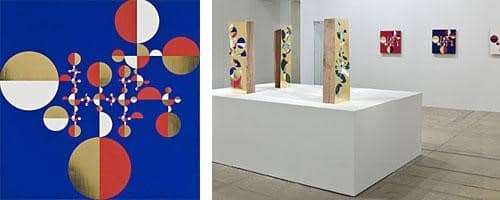Born on April 27, 1962, Gabriel Orozco is a Mexican artist. Orozco is a native of Jalapa in the state of Veracruz in Mexico. Gabriel Orozco studied at the Universidad Nacional Autónoma de México in Mexico City between 1981 and 1984 where he attended the Escuela Nacional de Artes Plásticas (Pompidou, 2009). Upon his graduation from the Mexican University, Orozco furthered his interests in arts by taking up a course in Circulo de Bellas Artes in Madrid from 1986 to 1987. Ever since he completed his studies, Orozco has traveled the world and lived in numerous cities including New York, Berlin, and Mexico City. Orozco became an established and equally famous artist in early 1990s when he created ingenious media products including sculptures, drawings, and photography. Some of his early works include the Sleeping Dog and Crazy Tourist, which he developed in 1990 and 1991 respectively.
Orozco’s work in media covers a span of various forms of art including illustrations, drawing, sculpture, videos, and photography. He argues that he indebts his aesthetic vocabulary in the arts to conceptualism, a dominant artistic tradition in Mexico. Furthermore, he borrows extensively from the ready-mades by Marcel Duchamp. The principal subject in most of Orozco’s works is the fragile relationship that exists between everyday objects and human beings in the contemporary human environment. He provides an analytical and artistic representation of the objects thereby offering an artistic and often partial criticism of the common phenomena. At the beginning of his career, he would place items in unexpected locations before documenting their presence in photographs. He did the same in a photograph he entitled Five Problems in 1992. He continued to utilize everyday objects in his works throughout the 1990s (Frank & Preble, 2014).
Gabriel Orozco began to exhibit his works in 1983. Some of his notable exhibitions included an exhibition at the Musée d’art moderne de la Ville de Paris between 1995 and 1998. In 2004, he exhibited his works in Washington DC at the Hirshhorn Museum and Sculpture Garden. In 2012, he held an exhibition in New York at the Guggenheim Museum. As a conceptual artist, Orozco bases his works on the notion that an idea or concept is the essence of art. He also believes that the idea or concept can exist in the absence of an object as its representation. In conceptual art, the ideas or concepts in the work takes precedence over any material, technical, aesthetic or even traditional concerns (Harrison, 2001). Conceptual art often strives to question the nature of art. Gabriel Orozco embodies similar ideals as he develops unique creations that appear random but analytical.

Crazy tourist, 1991


Empty Shoe Box, 1993

Samurai Tree Paintings, 2004
The three photographs are some of Gabriel Orozco’s famous works. The photographs are unique and embody the dictates of conceptualization. Crazy tourist, for example, is a photograph he took in Bahia in Brazil. The image is a representation of an empty market, a famous tourist market in the city. Orozco believes that his form of art should not document social developments with the view of becoming a relic. Instead, he strived to witness an ephemeral event especially events that occur when he as the artist was alone. The empty shoebox is yet another creative and thought-provoking series of photographs. He placed an empty shoebox on the empty floor of Aperto. While the shoebox appears a readymade, it reveals other underlying details as audiences begin to investigate both the box and its surrounding. Orozco thus comes out as an innovative artist who uses wit to draw attention and capture the developing details from simplistic motivations.
The samurai tree paintings, on the other hand, are abstract paintings with equally instrumental cultural motivation. Apparently, Orozco had begun toying with similar images numerous years ago on currency, graph paper, and airplane tickets among others. In the actual painting, he uses a computer program to create a circle around a point before dividing the circle into quadrants. He then painted the various parts of the quadrants and circles in multiple colors including red, blue and white. Circles are critical to Orozco’s type of art. The artist believes those circles are instruments of movement. He thus treats them as such. The same is the case in the Samurai Tree paintings since the circles have a centrifugal point from which they rotate and spin.
In retrospect, Orozco comes out as an exciting and equally clever artist who embodies the conceptualism as a movement of arts. I find most of his creations thought to provoke. The works appear random and ordinary at face value. However, an in-depth analysis of the works reveals a trail of thought that provides an analytical analysis of art as a medium of representation and criticism of developments in the society. My interpretation of the three works by Orozco relies on their simplicity and the normalcy that characterizes the subjects. The artist reveals that everyday objects have artistic value (Frank & Preble, 2014). One must strive to see the interrelation that exists in the various aspects of such objects.
- Alberro, A., & Stimson, B. (1999). Conceptual art: A critical anthology. Cambridge, Mass.: MIT Press.
- Frank, P., & Preble, D. (2014). Prebles’ Artforms: An introduction to the visual arts. Boston: Pearson.
- Harrison, C. (2001). Conceptual art and painting: Further essays on art & language. Cambridge, Mass: MIT Press.
- Temkin, A., Orozco, G., Museum of Modern Art (New York, N.Y.), Öffentliche Kunstsammlung Basel., & Centre Georges Pompidou. (2009). Gabriel Orozco. New York: Museum of Modern Art.
